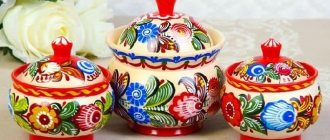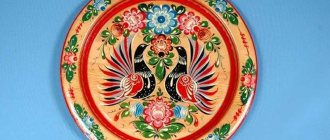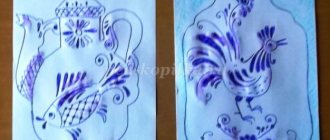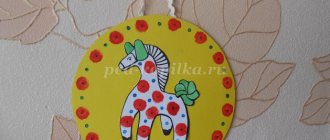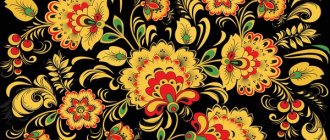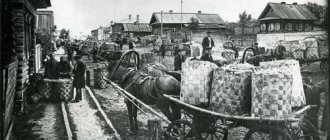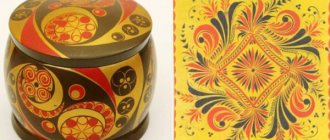History of origin
Gorodets painting originated in the 18th-19th centuries in the Nizhny Novgorod region. There were many talented woodcarvers here, whose products decorated the life and household utensils of the peasants. Fairs with wooden products were famous in this area.
According to history, earlier in every village they celebrated the day of Ivan Kupala and, in addition to mass celebrations and lighting bonfires, they looked for an unusual fern flower. It grew in the forest and bloomed only 1 night a year - on Ivan Kupala. Residents did not know what it really was and therefore endowed it with an individual shade.
Later, Nizhny Novgorod craftsmen decorated wood products with amazing fern flowers. Some were bright red, others were sunny, and some were black. They were called kupavs with fern leaves. It was believed that such a symbol would bring prosperity and happiness to the house.
Also in those days, every house had a dismountable spinning wheel. After working on it, the bottom on which the comb was attached was hung on the wall. To attract attention, they began to decorate it with paintings. When fabrics became cheaper, the spinning wheels were hidden, and master carvers, in addition to the bottoms, began to decorate other utensils, including dishes, furniture, and children's toys with strange images.
Description of Gorodets painting
Gorodets painting of the 19th century.
Volga region craftsmen had been engaged in wood carving for a long time: each ship was decorated with elegant processing according to the idea of Peter I. And the military power needed to be shown, the sovereign believed, and the artistic talent of the people. But when shipbuilding moved closer to the seashores, craftsmen from the Volga region began to look for a new niche for themselves. Some began to carve spoons, others - bowls, cups, and others specialized in spinning wheels. Gorodets painting began with these spinning wheels.
At first it was wood inlay, but later, to improve the presentation and save consumables, as well as make labor easier, craftsmen began to tint spinning wheels. Egg paints made spinning wheels bright, recognizable, and most importantly, in demand. The laws of the market always work - this is how the famous Gorodets painting appeared.
Quite realistic brides, fantasy horsemen, and even exotic palm trees could appear on the boards and bottoms of the spinning wheels.
The name stuck because Gorodets (following Nizhny Novgorod) was the main market for painted goods. Today you will only see spinning wheels in a museum, but the beautiful, eye-pleasing painting still lives on. And most often you can see Gorodets painting on a cutting board.
Features of the fishery:
- in most cases, craftsmen painted products without applying a preliminary drawing, but they could also use sketches in color;
- the artist's first works were flat carpentry (the same cutting boards);
- the background of the product – from light yellow to dark red, strictly corresponds to the artist’s intention;
- Gorodets painting is distinguished by small but elegant details - shading, light shading, curved strokes;
- After drying, the finished work is secured with varnish;
- the general rules of Gorodets painting, however, do not contradict the appearance of original versions.
Art historians are interested in thematic pictures of the craft: they show not only the life of the Russian people, but also very specific historical events.
And, what is especially important, in the early works a solution characteristic of Russian folk art was noted - a harmonious combination of reality and fantasy. Quite realistic brides, fantasy horsemen, and even exotic palm trees could appear on the boards and bottoms of the spinning wheels.
You can get acquainted more fully with Gorodets painting in our review article: “What is Gorodets painting: history, types, description, features of painting for children.”
Drawing tools
True masters say that the most important thing in their work is their state of mind. It must be pure, enlightened. It is necessary to fully concentrate on the artistic work that lies ahead in the next few minutes.
A modern person, accustomed to the fast pace of life, even with the greatest desire, cannot for a short time renounce everyday worldly worries and problems, as skillful icon painters who lived several centuries ago did. However, focusing on creativity must be learned.
You should start with organizing your workplace, paying attention to the following aspects:
| Aspect | Description |
| Table | Gorodets craftsmen differ from Khokhloma and Bogorodsk craftsmen in that during their work they can sit at ordinary tables. The working surface does not have to be located at the level of the seated person’s knees. Khokhloma and Bogorodsk masters should have long tables, but Gorodets artists work on tables of ordinary length. Beginner creators are advised to ensure that the table is wider, preferably with a footrest |
| Chair | The chair on which the artist will sit should be positioned so that the rays of light are on the left side |
| Lighting | It is better to give preference to natural light. To do this, you can sit near a window where the sun is shining. If this is not possible, you can use a lighting device. The lamp should be bright and located so that the canvas on which it is planned to paint is evenly illuminated. All areas of this canvas should receive approximately the same amount of light. Only in this case will the light emitted by the device be close to natural light |
| Room | One of the main conditions is that the work area must be well ventilated. Failure to comply with this requirement may lead to an allergic reaction as a result of prolonged interaction with paints, varnishes, solvents and other chemicals that are not very beneficial to health. |
To avoid excessive stress during the process, experts recommend that you immediately get used to the working position.
To do this, the artist needs:
- be positioned straight;
- tilt your head a little;
- make sure that the distance between the eyes and the canvas is just over 30 cm;
- During the process, draw with both the brush and the entire upper limb, starting from the forearm.
Sometimes the artist holds his hands suspended: with his left he supports the wooden product, and with his right he directly carries out the painting itself. Sometimes the master's forearms rest on the surface of the table. This happens, for example, when painting a flat plate.
Before starting work, it is necessary to correctly place on the table surface all the equipment that you plan to use. If this is not done, then fuss will begin during work. For this reason, real masters follow a strictly routine order in placing paints and painting tools on the table.
Namely:
- The place in front of the master is free. Items that will be needed in the work will be placed here;
- it is necessary to allocate a space of approximately 0.5 square meters. m to accommodate 2-3 small boards. They should lie so as not to interfere with each other. Next time, the master can replace the boards with wooden spoons or boxes that are to be painted;
- Place containers with paints and a palette near the products. The latter is a wide plate of glass or plastic. The main condition is that its surface should be easy to clean;
- Place a vessel with water on the table and put a small cloth.
For a beginning craftsman, the main tools will be brushes, paper and paints.
Paper
You will need white paper. You can take a leaf from a school album.
Paints
Gorodets masters perform painting elements with oil paints, so you can follow their example. However, a novice painting artist is recommended to use gouache. This could be a kit for schoolchildren.
Black, white, scarlet, cherry and bright blue are used pure, and yellow, dark green and red are used to obtain new colors. If you mix them correctly, you get a gamma similar to Gorodets.
You will also need cinnabar to work. This is a material that has a bright red color. It is expensive, so many beginning artists do without it at first. However, without cinnabar it will not be possible to make a good painting.
An artist working with gouache must remember: before starting to apply the 2nd layer, you must wait until the previously applied layer has completely dried. If this is not done, the image will take on a whitish tint.
Brushes
Craftsmen use various brushes to apply paint to a wooden product. Their exact number and size depend on what techniques will be used, as well as on the scale of the work. Artists can work for several days to create one masterpiece.
All brushes must be placed on special wooden stands.
Gorodets painting (elements of painting are done without a layout) will require 3 artistic brushes:
- squirrel under No. 2 or No. 3;
- core under No. 1 or No. 2;
- flute made of soft hair.
After use, each brush should be thoroughly washed and dried.
Features of Gorodets painting
The main difference between this craft is its content. Each element of the image serves as a storyteller, painting not only a visually appealing series, but also an entire story. The apotheosis of the meaningfulness of Gorodets painting is genre scenes. They are free and quite conventional in nature, sometimes even bordering on caricature. But at the same time, they are very interesting to look at and “read.”
In Gorodets painting, realistic motifs often coexist with idealized ones. The images of animals and birds are very decorative. On painted items you can see lions and leopards, which, naturally, were exotic animals for Russia. But even the usual horse appears on the painted board as a hot, strong, and at the same time graceful animal, his pose is proud and warlike, and he himself appears not as a draft force, but as a royal animal.
It is not uncommon for Gorodets painting to have paired images, elements facing each other.
It is not uncommon for Gorodets painting to have paired images, elements facing each other. Where the plot requires it, the artist uses the motif of a magnificent curtain. The most preferred colors: bright red, expressive green, deep blue, black. The painting is done with a brush; no preliminary drawing is applied. The technique involves both broad strokes and the finest lines, the virtuosity of drawing which requires skill and experience.
What you need to buy for lessons
A modern approach today allows us to apply technologies for using Gorodets painting not only on wood, as it was originally, but also on an ordinary sheet of paper. In the school curriculum, children are introduced to the methods of depicting animals and patterns of Gorodets masters.
To conduct lessons for children, you need to purchase the necessary supplies.
- The material on which the design will be depicted. For children who are just starting to take their first steps in Gorodets painting, the ideal option would be plain paper or cardboard (not glossy).
For those who have already acquired skills in imaging techniques, you can use wooden blanks for work. These can be cutting boards, plates, etc.
- Dye. Her choice also largely depends on how much children practice this skill. If you are a beginner, then gouache paints are suitable. Most common sets of 12 can be used.
- Tassels. They need to be selected in different sizes. It is better if they are brushes made of natural bristles.
- Varnish. If you draw on a wooden surface, then after drying the drawing must be secured with transparent varnish. It will protect the drawing from damage and prevent the colors from fading.
Current techniques for Gorodets painting
First, the teacher introduces children to the main elements of the Gorodets pattern - flowers and leaves. The first are varied in color and shape, but the main types are rose, bud and chamomile.
Drawing a flower always begins with a circle, and then smaller elements are indicated inside with a thin brush. Rosean and chamomile have a pronounced center (a large spot of contrasting color). The first is surrounded by brackets - rounded petals that do not reach the center, but match it in color; the second flower has elongated petals and starts from the center. For a bud, the pattern begins from the edge of the circle - in the form of a spot and semicircles diverging from it.
The rose and the bud have a clearly defined center around which the petals are formed, but the bud is drawn differently
The leaves in the Gorodets ornament are also varied in shape and size. As a rule, they are located in groups of several pieces or on a branch. The leaves are directed in different directions; they can be round or more elongated. For large leaves you can mark an outline; for small leaves this is not necessary.
The simplest Gorodets leaf is depicted in the shape of a pumpkin seed.
The leaves are arranged in groups (looking in different directions) or on a branch
Preschoolers should learn about the basic techniques of Gorodets painting:
- Underpainting. This is a circular motion with the brush to apply a single spot, such as the base of a flower. The underpainting is done with a wide brush. It is important to get the right amount of paint. After all, if there is not enough of it, the drawing will turn out to be pale and inexpressive, and if there is too much, the paint will then begin to peel off.
Underpainting is a circular motion with a wide flat brush to apply a circular spot of color.
- Shadow. Using darker colors (compared to a large element). For example, if a flower is pink, then its center and petals will be burgundy; if the leaf is light green, then its veins will be black. In this case, a thin or medium-sized brush is used. The drawing itself is done carefully. For example, to depict the petal brackets of a rose, you need to touch the tips to the paper, then draw the bow with the entire brush and mark its end again with the tip.
When shading, a darker tone of paint is used than when underpainting, for example, pink is shaded with dark burgundy
- Revive. These are white or black strokes in the form of droplets, strokes, dots, arcs, and spirals. They seem to enliven the pattern, make it elegant, and add a unique beauty to Gorodets painting. The animation is done with the tip of a thin brush, very carefully.
It is the revival that makes the Gorodets pattern unique, as if it brings it to life
Of course, Gorodets craftsmen also paint more complex objects on their products, for example, a bird or a horse. However, for older preschoolers this will not be very easy. But the teacher can try to explain to the children the process of drawing a bird (after successfully depicting simpler ornaments), accompanying it with a step-by-step drawing diagram. In addition, you can offer appropriate templates: the guys will simply circle them and draw them.
You can try to draw a bird with preschoolers - a more complex element of painting
An important part of teaching students of the senior group Gorodets painting is thinking through the composition of the drawing. To do this, on the basis, children are allowed to outline the approximate location of the main elements with a simple pencil. This can be used as part of an individual approach - for children who find it difficult to immediately determine the composition.
Another point is to remind preschoolers about the need to mix paints. After all, flowers look very beautiful in soft pink and blue colors. Similarly, by mixing green gouache with white, you can get various shades of leaves.
Gorodets flowers look beautiful in soft pink and blue colors
Step-by-step creation of the composition “Buds with leaves”
- Preschoolers are offered a round base, tinted to look like wood. Just below the center, underpainting circles are depicted: in the middle there is a larger pink one, on the sides and a little higher there are smaller blue ones (children first mix the paints to obtain the desired shades).
There is a pink circle just below the center, smaller blue circles on the sides and just above
- On the edge of the pink circle, partially extending beyond its limits, you need to draw a small red circle. A similar shading is done on blue circles using blue paint.
The spot should be on the edge of the large circle and partially extend beyond it
- Next, the central bud is complemented by red petals around a large circle, and blue arches are simply drawn on the side ones.
The central bud will have rounded petals and the side ones will be decorated with arches
- Now you need to draw leaves and twigs. Symmetrical prints are obtained by applying a brush.
Neat leaves are obtained using the dipping technique
- The final and most important stage is the “revival” of the flower arrangement. Using a thin brush, apply dots, droplets, strokes, and arcs with a light touch. Here it is important not to get too carried away and maintain a sense of proportion.
It is important to maintain a sense of proportion so that there is not too much excitement

